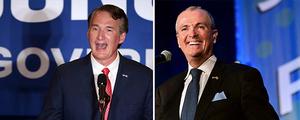PRINCETON, NJ -- Some six months before voters head to the polls to choose the next president of the United States, Gallup finds several indicators of the economic and political climate holding steady at levels that could be troublesome for President Barack Obama. According to Gallup polling in early May, Obama's approval rating is below 50%, Americans' satisfaction with the direction of the country is barely above 20%, and the economy remains a dominant concern.
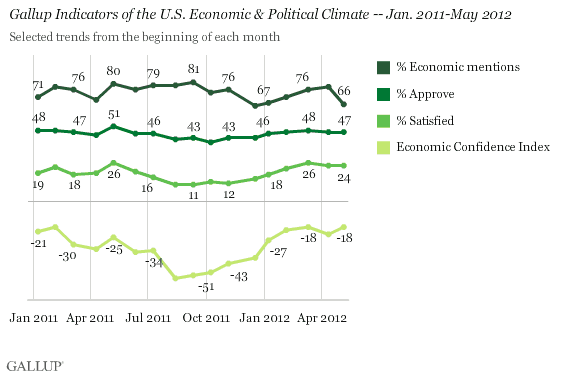
More specifically, in Gallup Daily tracking for the first full week of May, Obama's job approval rating averaged 47% and the Gallup Economic Confidence Index averaged -18. Separately, in a May 3-6 Gallup poll, 24% of Americans were satisfied with the way things are going in the country and 66% mentioned one of five economic issues as the "most important problem" facing the country.
All four indicators are higher today than last summer when public confidence in the president and the economy were at low points for this administration, but they have barely recovered to where they stood prior to the lows. In general, attitudes have returned to match or slightly exceed the already-suppressed levels Gallup found early in 2011, but have shown little to no further upward momentum so far in May.
Historical Comparisons Are Mostly Inauspicious for Obama
Comparing today's economic and political ratings with those from previous years when presidents sought re-election reveals that today's climate is more similar to years when incumbents lost than when they won.
Perhaps the broadest indicator of the public's mood comes from Gallup's satisfaction measure, which asks Americans if they are satisfied or dissatisfied with "the way things are going in the United States at this time." The 24% of Americans currently satisfied is most similar to the 20% recorded in May 1992 during George H.W. Bush's first and only term. Bush was also the only sitting president of the last four to lose his re-election bid.
By contrast, satisfaction was above 35% in May of 1996 and 2004, in advance of Bill Clinton's and George W. Bush's re-elections. And it was 48% in September 1984, the closest time period Gallup has to May of Ronald Reagan's re-election year.
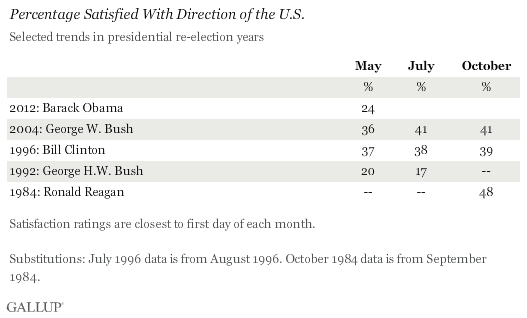
The extent of Americans' concern about the economy -- as evident in their top-of-mind mentions of it as the nation's "most important problem" -- is greater today than for any president seeking re-election since Jimmy Carter in 1980. The current 66% mentioning one or more economic concerns is substantially higher than it was in May 2004 or May 1996, and moderately higher than at the same point in 1992 and 1984. Americans' mentions of the economy did surge in August 1984 to 65% -- comparable to where they are today -- but fell to 51% by September.
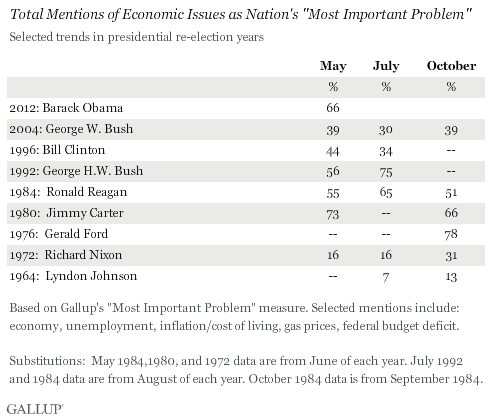
Gallup's Economic Confidence Index -- a summary of whether Americans have mostly positive or negative views of the economy and its direction -- was instituted in 1992. According to the incumbent re-election year trends since that time, the -18 reading in May 2012 is significantly lower than it was in May 2004 or May 1996, but significantly better than the -31 seen in June 1992. Economic confidence improved between May and October of 2004 and 1996, but worsened in 1992 from June to August.
Which direction economic confidence takes for the remainder of 2012 could determine Obama's re-election. According to a recent Gallup analysis of the relationship between economic confidence and Obama's overall job approval rating, even a slight improvement in the weekly average of the Index -- to between -16 and -13 -- could help push Obama's job approval to 50%, where it needs to be to largely ensure his re-election.
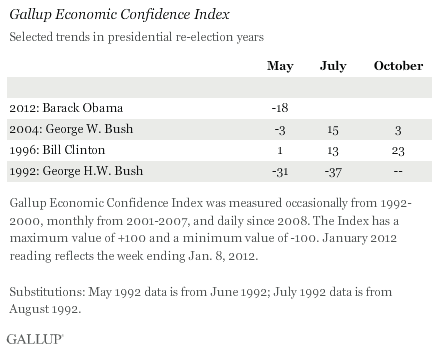
Despite the largely negative implications of Americans' low satisfaction with the state of the country and high level of concern about the economy, Obama's overall job approval rating is in a gray zone when it comes to historical precedents for re-election.
All presidents since Lyndon Johnson who won re-election (Johnson, Richard Nixon, Reagan, Clinton, and George W. Bush) had job approval ratings of 49% or higher in May of their re-election year. All presidents who lost their re-election bid (Gerald Ford, Jimmy Carter, and George H.W. Bush) had approval ratings of 43% or lower. Thus, Obama's 47% in early May fits in neither category, although it is closest to George W. Bush's 49% in 2004.
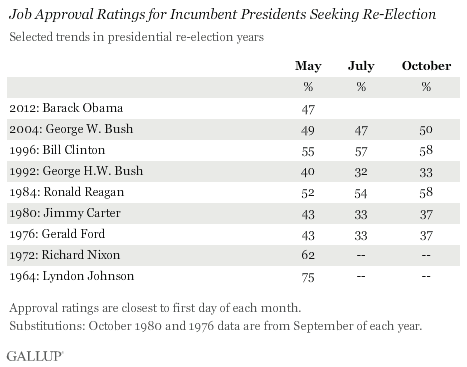
Bottom Line
President Obama is running for re-election with Americans feeling about as dissatisfied with the country and the economy as they were in 1992 when George H.W. Bush lost. However, with a modest 47% job approval average in early May, his approval rating is nearly the same as in 2004 when George W. Bush won. This makes Obama's re-election prospects quite uncertain, but supports the results of Gallup's trial heat tracking showing Obama and Romney essentially locked in a statistical tie.
Gallup.com reports results from these indexes in daily, weekly, and monthly averages and in Gallup.com stories. Complete trend data are always available to view and export in the following charts:
Daily: Employment, Economic Confidence, Job Creation, Consumer Spending
Weekly: Employment, Economic Confidence, Job Creation, Consumer Spending
Read more about Gallup's economic measures.
View our economic release schedule.
Explore President Obama's approval ratings in depth and compare them with those of past presidents in the Gallup Presidential Job Approval Center.
Survey Methods
The May 2012 results for U.S. satisfaction and Most Important Problem are from a Gallup poll conducted May 3-6, 2012, with a random sample of 1,024 adults, aged 18 and older, living in all 50 U.S. states and the District of Columbia.
The May 2012 results for President Obama's job approval rating are based on telephone interviews conducted as part of Gallup Daily tracking May 7-13, 2012, with a random half-sample of 3,653 adults, aged 18 and older, living in all 50 U.S. states and the District of Columbia. For results based on this sample of national adults, one can say with 95% confidence that the maximum margin of sampling error is ±2 percentage points.
The May 2012 results for the Gallup Economic Confidence Index are based on telephone interviews conducted as part of Gallup Daily tracking May 7-13, 2012, with a random half-sample of 3,398 adults, aged 18 and older, living in all 50 U.S. states and the District of Columbia. For results based on this sample of national adults, one can say with 95% confidence that the maximum margin of sampling error is ±2 percentage points.
Interviews are conducted with respondents on landline telephones and cellular phones, with interviews conducted in Spanish for respondents who are primarily Spanish-speaking. Each sample includes a minimum quota of 400 cell phone respondents and 600 landline respondents per 1,000 national adults, with additional minimum quotas among landline respondents by region. Landline telephone numbers are chosen at random among listed telephone numbers. Cell phones numbers are selected using random digit dial methods. Landline respondents are chosen at random within each household on the basis of which member had the most recent birthday.
Samples are weighted by gender, age, race, Hispanic ethnicity, education, region, adults in the household, and phone status (cell phone-only/landline only/both, cell phone mostly, and having an unlisted landline number). Demographic weighting targets are based on the March 2011 Current Population Survey figures for the aged 18 and older non-institutionalized population living in U.S. telephone households. All reported margins of sampling error include the computed design effects for weighting and sample design.
In addition to sampling error, question wording and practical difficulties in conducting surveys can introduce error or bias into the findings of public opinion polls.
For more details on Gallup's polling methodology, visit https://www.gallup.com/.
